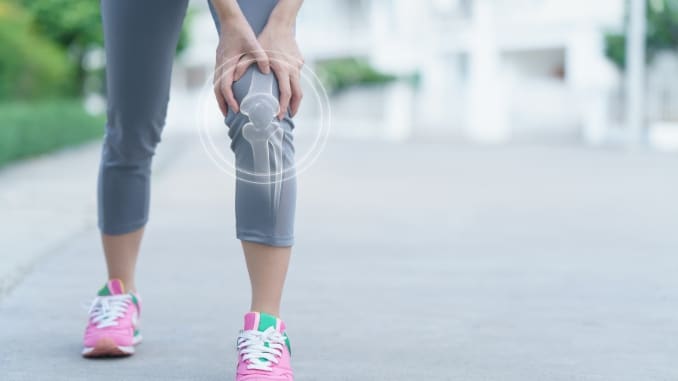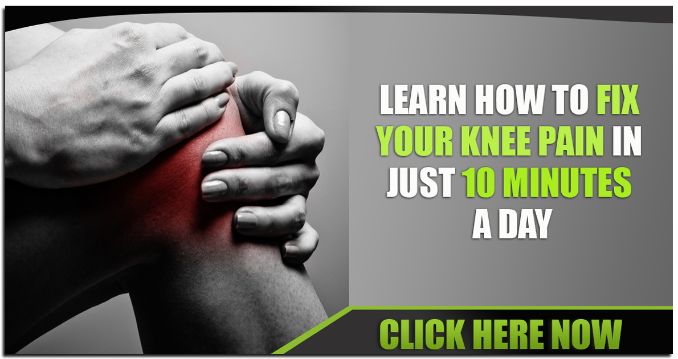Knee buckling is a common issue that plagues many individuals and can also be disturbing, but targeted knee buckling exercises can help manage the condition.
Imagine walking down the street, and suddenly, your knees give way, causing you to stumble or fall.
This is embarrassing and can indicate an underlying problem, such as a knee injury or pain.
This article will explore the factors behind knee buckling, strategies for averting it, and the diverse treatment options and exercises for buckling knees.
1. Single Leg Squats
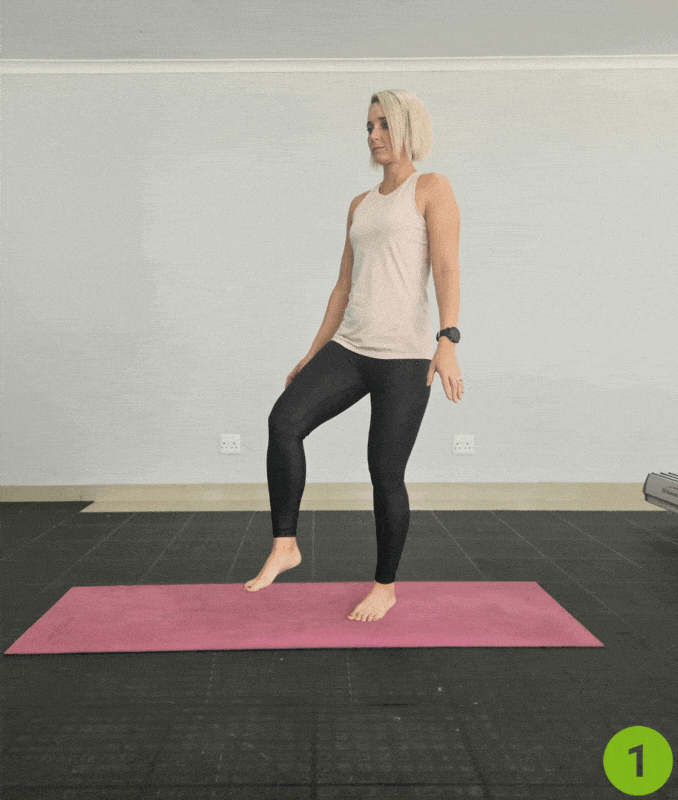
- Begin in an upright standing position with your feet about hip-width apart, maintaining good alignment with your head, shoulders, hips, and legs.
- Engage your core and transfer all of your weight onto one foot.
- Bend your supporting knee and hinge through your hips to lower into a squat position, keeping your knee behind your toes.
- After that, try to lower yourself as far as your flexibility and strength allow.
- Hold the position for a couple of seconds.
- Relax and return to the starting position.
- Repeat the movement.
- After several repetitions, repeat the movement on the opposite leg.
Single leg squats are a powerful exercise for boosting knee stability and strength, making them an excellent choice for anyone looking to treat knee pain and prevent knee buckling [3].
2. Seated Single Leg Abduction with Resistance Band

- Begin in an upright sitting position on a stability ball with your knees bent and feet flat on the floor.
- Maintain good alignment with your head, shoulders, and hips.
- After that, loop the resistance band around both legs just above your knees.
- Engage your core and slowly open your right leg out to the side, squeezing your outer thigh muscles and creating resistance on the band.
- Hold the position for a couple of seconds, then return to the starting position.
- Repeat the movement.
- Start off with 1 set of 10-15 repetitions on each side.
3. Standard Seated Leg Abduction

For this exercise, use a resistance band to increase the level of resistance.
- Begin in an upright sitting position on a stability ball with your knees bent and feet flat on the floor.
- Maintain good alignment with your head, shoulders, and hips.
- Loop the resistance band around both legs just above your knees.
- Engage your core, then bring your legs out to the sides, creating resistance on the band.
- Hold the position for a couple of seconds, then return to the starting position.
- Repeat the movement.
- Complete 10-15 repetitions.
Keep firm control over your leg’s movement while performing the routine, making sure to execute smooth opening and closing actions.
You can gradually increase the resistance as you become stronger and more comfortable with the exercise.
4. Squats
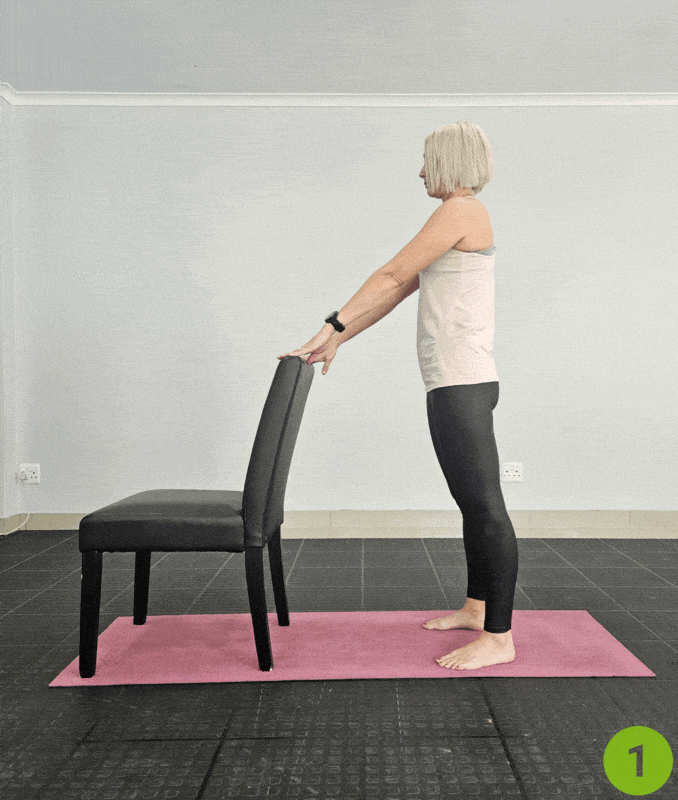
For this exercise, utilize the back of the chair, wall, or anything stable that you can hold on to for support if needed.
- Begin in an upright standing position in front of a chair with your feet shoulder-width apart, maintaining good alignment with your head, shoulders, hips, and legs.
- Engage your core and hold on to the back of the chair for support if needed.
- Bend your knees and hinge through your hips to move into a squat position, keeping your knees behind your toes.
- After that, raise back up to an upright standing position, squeezing your glutes at the top position.
- Squats also engage your calf muscles, helping to build lower leg strength and stability.
- Repeat the movements for 10 repetitions.
For added resistance, loop the resistance band around your legs just above your knees.
5. Squatted Single Leg Abduction with Resistance Band
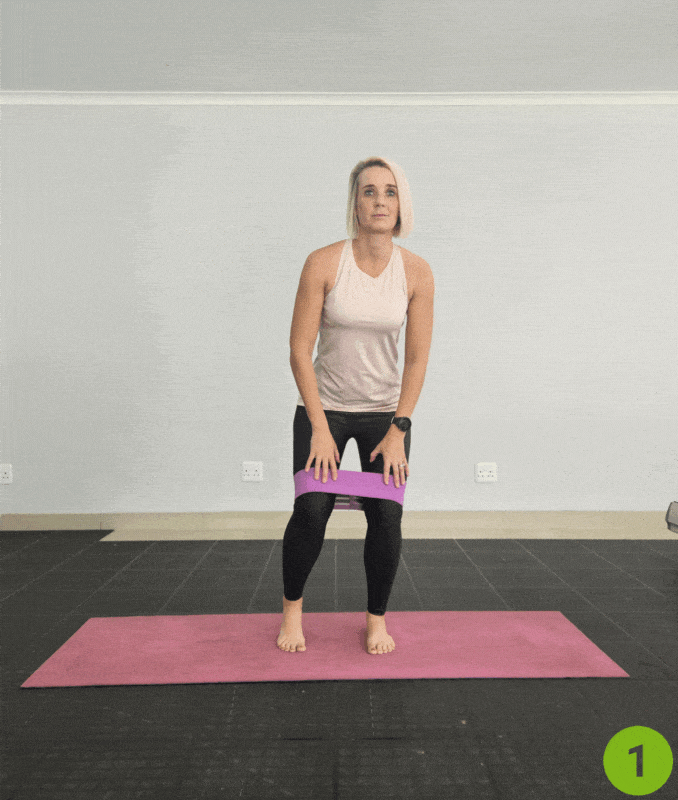
For this exercise, use a resistance band to increase the level of resistance.
- Begin in an upright standing position with your feet hip-width apart, maintaining good alignment with your head, shoulders, hips, and legs.
- For knee buckling exercises, wrap the resistance band across your legs just above your knees.
- Bend through your hips and knees to move into a semi-squat position.
- Engage your core and gently open your right leg out to the side, creating resistance to the band.
- Relax and return to the starting position.
- Repeat the movement.
- After several repetitions, perform the movement on the opposite leg.
- Complete 10 repetitions on each side.
Keep firm control over your leg’s movement while performing the routine, making sure to execute smooth opening and closing actions.
Focus on keeping your ankles stable and then engaged throughout the movement to improve lower limb stability.
You can gradually increase the resistance as you become stronger and more comfortable with the exercise.
6. Lunged Single Leg Abduction with Resistance Band

For this exercise, use a resistance band to increase the level of resistance.
- Begin in an upright standing position with your feet hip-width apart, maintaining good alignment with your head, shoulders, hips, and legs.
- Wrap the resistance band around your left leg as you hold the band together with your opposite hand.
- Take a big step back with your right leg and then lower your back knee halfway to the ground to move into a lunge position.
- Engage your core and open your left leg out to the side, creating resistance on the band.
- Return to the starting position and then repeat the movement.
- After several repetitions, perform the movement on the opposite side.
If maintaining balance is difficult, hold on to something stable for support while performing the exercise, ensuring that your form remains correct.
You can gradually go deeper with your lunges as you become stronger and more comfortable in the routine.
This exercise also helps strengthen the hip joint, which is important for overall knee stability.
7. Low Lunge with Resistance Band
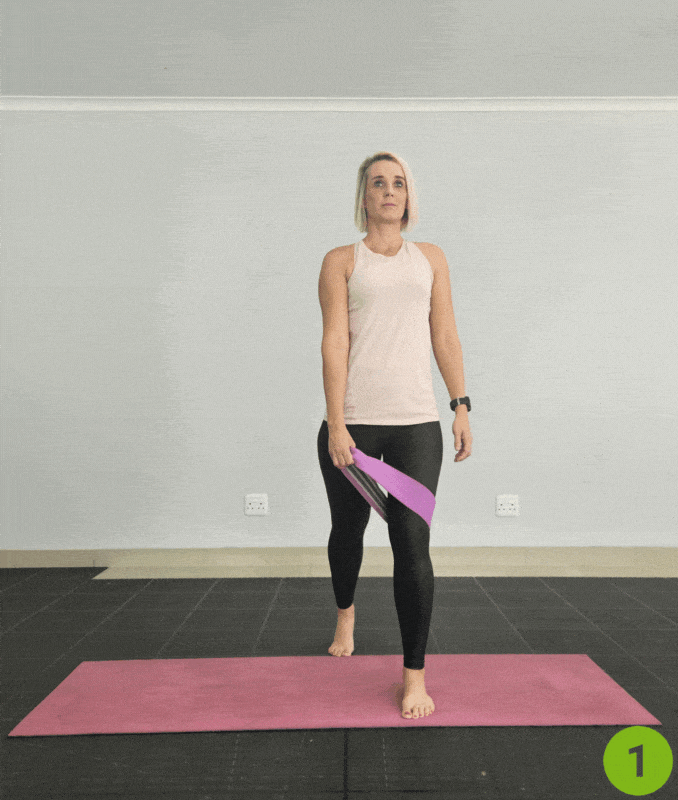
For this exercise, use a resistance band to increase the level of resistance and focus on strengthening and stabilizing one knee at a time.
- Begin in an upright standing position with your feet hip-width apart, maintaining good alignment with your head, shoulders, hips, and legs.
- Wrap the resistance band around your left leg as you hold the band together with your opposite hand.
- Take a big step back with your right foot and bend your front knee directly over your ankle, targeting one knee during the movement.
- Straighten your back leg as you stack your back heel over your toes, shifting your pelvis as you press through your back toes.
- As part of your knee buckling exercises, gently pull the resistance band to align your bent knee with your hip.
- Return to the starting position and repeat the movement.
- After several repetitions, perform the movement on the opposite side to work the other knee.
Ensure that you maintain correct posture and balance when incorporating a resistance band into your exercise routine.
What is Knee Buckling?
Knee buckling, scientifically known as “knee instability,” refers to a sudden and involuntary giving way or collapsing of the knee joint, leading to a loss of balance and potentially causing a fall or injury.
This phenomenon occurs when the muscles, ligaments, and other supporting structures around the knee joint cannot maintain stability during weight-bearing activities.
Treatment for knee buckling typically involves addressing the underlying cause and may include knee buckling exercises to improve strength and stability.
This might involve physical therapy at fortifying the muscles surrounding the knee, using supportive braces or taping for added support, or surgical interventions to repair damaged ligaments or cartilage.
In some cases, lifestyle modifications and exercises for buckling knees to improve balance and proprioception (awareness of body position) can help reduce the risk of knee buckling.
Seeking guidance from a healthcare expert, be it a physical therapist or an orthopedic surgeon, is of utmost importance for an accurate diagnosis and appropriate management of knee instability to prevent further injury and improve quality of life.
Knee Injury: Knee Pain vs. Knee Buckling
A knee injury can manifest in various ways, and two common symptoms associated with knee problems are knee pain and knee buckling.
Knee Pain:
Knee pain is a prevalent symptom of common knee injuries and can result from various causes such as ligament sprains, muscle strains, meniscus tears, rheumatoid arthritis, or overuse.
The pain may vary in intensity and location depending on the underlying issue.
It can be sharp, dull, or also throbbing and might be felt in the knee joint’s front, back, or sides.
Knee pain often worsens with movement or weight-bearing activities like walking, running, or climbing stairs.
During an injury’s early stages, Rest, Ice, Compression, and Elevation (RICE) can effectively relieve pain.
Still, it’s essential to consult a healthcare professional for a proper diagnosis and treatment plan.
Knee Buckling:
Knee buckling, on the other hand, refers to a sudden and unexpected give-way sensation in the knee joint.
It can feel like the affected knee is about to collapse or give out, making it challenging to maintain balance and stability.
Knee buckling can occur for various reasons, including ligament instability, muscle weakness or imbalances, or also problems with the knee’s structural components.
People who experience knee buckling may need assistive devices like a knee brace or crutches to avoid falls and further injury.
Physical therapy is often recommended to improve the knee buckles stability and strength.
In addition, anterior knee pain is a common symptom of common knee injuries and can be characterized by discomfort or agony in and around the knee joint.
Knee buckling, on the other hand, is a sudden loss of knee stability, leading to a feeling of the knee giving way.
Both symptoms can be signs of underlying knee issues, and it’s crucial to seek medical evaluation and treatment if you experience either of them to avert additional issues and facilitate the process of effective recovery.
Knee Joint

The human body boasts one of its largest and most intricate joints: the knee joint. It is located at the junction of the thigh bone (femur), the shinbone (tibia), and the kneecap (patella).
The knee joint permits a broad spectrum of motion, encompassing bending (flexion) and then straightening (extension) of the leg and limited rotation.
This flexibility is essential for various activities such as walking, running, jumping, and kneeling.
What’s Causing Knee Buckling or Knee Instability?
The causes of knee buckling can be attributed to various factors rooted in the biomechanics and physiology of the knee joint.
These 10 causes of Knee Buckling or Knee Instability include:
1. Muscle Weakness
Weakness in the muscles surrounding the knee, particularly the quadriceps and hamstrings, can compromise the joint’s stability. These muscles play crucial role in supporting and controlling knee movements.
2. Ligamentous Injuries
Injury to the ligaments in the knee, including the ACL (Anterior Cruciate Ligament) [1], MCL (Medial Collateral Ligament), LCL (Lateral Collateral Ligament), or PCL (Posterior Cruciate Ligament), can result in a loss of stability. Certainly, these ligaments play a vital role in preserving the structural stability of the joint.
3. Torn Meniscus
Tears or damage to the meniscus, which are cartilage-like structures in the knee joint, can result in stability. The menisci provide cushioning and support for the joint.
4. Arthritis
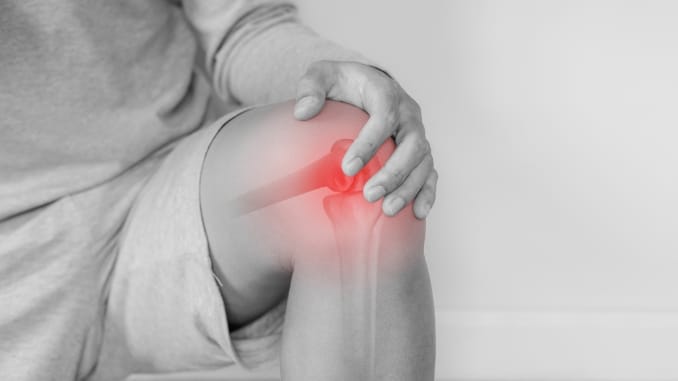
Degenerative conditions like knee osteoarthritis or inflammatory knee arthritis [2] can erode the cartilage and joint surfaces, leading to instability over time.
5. Neurological Factors
Certain neurological conditions, such as peripheral neuropathy or conditions affecting the nerves controlling knee muscles, can disrupt the coordination and control of knee movements.
6. Age and Degeneration
As individuals age, natural wear and tear of joint structures, including the cartilage and bones, can contribute to knee instability. Loss of muscle mass and strength is also common with aging.
7. Previous Injuries
As individuals age, natural wear and tear of joint structures, including the cartilage and bones, can contribute to knee instability. Aging often results in a decrease in muscle mass and also strength.
8. Overuse or Overexertion
Excessive or repetitive stress on the knee joint, often seen in sports or activities that involve running and jumping, can also lead to temporary instability.
9. Inadequate Footwear
Wearing improper or ill-fitting footwear can affect the alignment and stability of the knee joints, potentially leading to knee buckling.
10. Other Medical Conditions
Certain medical conditions, such as gout or systemic diseases affecting the joints, can contribute to knee instability. The specific cause of knee buckling can vary from person to person, often resulting from a combination of factors.
A healthcare professional’s precise diagnosis is also crucial for identifying the underlying cause and formulating a suitable treatment plan, which might encompass physical therapy, bracing, medication, or, in some cases, surgical interventions to address the root problem and improve knee stability.
Diagnosis and Treatment
Diagnosing the root cause of knee buckling begins with a thorough physical examination and a detailed review of your medical history.
A healthcare provider, such as a physical therapist or orthopedic specialist, may evaluate:
- Muscle strength and then flexibility
- Joint alignment and then movement
- Balance and then coordination
- Gait analysis and posture
Lifestyle Adjustments:
- Incorporate specific stretches to improve flexibility, reduce muscular imbalances, and then support knee health.
- Engage in low-impact exercises
- Use supportive footwear
- Maintain a healthy weight
Diagnostic Tools May Include:
- MRI scans to identify soft tissue injuries like ligament or meniscus tears
- X-rays to reveal bone alignment issues or arthritis
- Neurological assessments for nerve-related instability
Treatment Options
Treatment is tailored to the individual and then the root cause.
Here are the common strategies:
- Physical Therapy: Focused on restoring muscle balance, strength, and then joint control. Many exercises are performed while you lie on your back or side to target specific muscle groups.
- Step-ups: Step-ups are an effective exercise for strengthening the muscles around the knee joint, improving knee strength and stability.
- Bracing: Knee braces can provide support and limit excessive movement.
- Medication: Anti-inflammatories or pain relief when swelling or arthritis is involved.
- Surgical Intervention: In cases of severe ligament damage or structural breakdown.
- Lifestyle Adjustments
- Switching to supportive footwear
- Modifying workouts to reduce joint strain
- Incorporating balance and proprioception training
By identifying the underlying issue early and applying the appropriate treatment, many people can significantly reduce or eliminate episodes of knee buckling and regain the confidence to move freely.
Dr. James Andrews, a renowned American orthopedic surgeon and sports medicine expert, emphasizes the importance of strengthening the muscles surrounding the knee, particularly the quadriceps and hamstrings, to enhance stability and prevent knee buckling. He advocates for targeted exercises that bolster these muscle groups, thereby reducing the risk of instability and associated injuries.
Anterior Cruciate Ligament
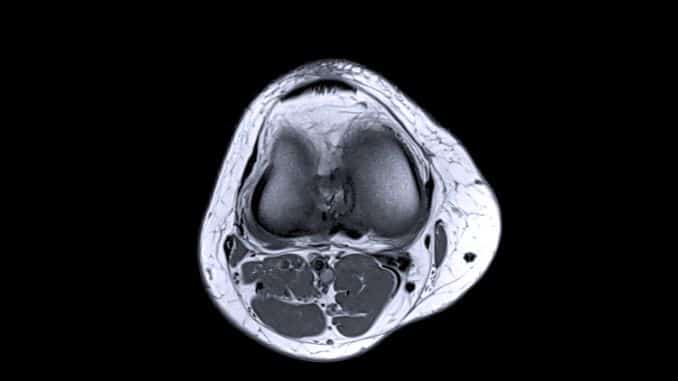
The human knee joint has four major ligaments, and the ACL (Anterior Cruciate Ligament) is one of them.
Its robust strip of connective tissue fulfills a crucial function in preserving the knee’s stability and controlling its range of motion.
The ACL is situated deep within the knee joint and runs diagonally from the back of the femur (thighbone) to the front of the shinbone (tibia).
The main purpose of the tibial brace is to hinder excessive forward motion of the shin bone concerning the thigh bone and also maintaining the stability of knee rotation.
Furthermore, the ACL is a vital ligament in the knee joint that maintains knee stability.
Its integrity is crucial for preventing knee buckling, and ACL injury can result in episodes of joint instability and knee buckling during physical activities.
Proper diagnosis and appropriate treatment, such as surgical reconstruction, knee brace, or rehabilitation, may be necessary to restore knee stability in cases of ACL injury.
Conclusion:
The phenomenon of buckling knees, or knee buckling, can be both disturbing and debilitating.
Whether caused by muscle weakness, ligamentous injuries, or other factors, it’s essential to address this issue promptly to maintain mobility and overall quality of life.
This article has provided valuable insights into managing knee buckling, from identifying the causes and symptoms to exploring treatment options and exercises buckling knees to improve knee stability.
Remember that seeking professional medical advice and guidance is crucial when dealing with knee buckling.
A healthcare professional, such as an orthopedic surgeon or physical therapist, can offer a tailored diagnosis and treatment plan to address the underlying causes and help you regain confidence in your ability to move freely without fearing your knees giving way.
By understanding the factors contributing to reducing knee buckling and actively working on strengthening the knee joint through exercises and lifestyle modifications, you can take proactive steps to prevent further issues and enjoy a more stable and active life.
So, don’t let knee buckling hold you back—take charge of your knee health, consult a healthcare expert, and embark on a journey toward improved stability and well-being.
Don’t let aching joints hold you back any longer. Discover the proven methods inside Knee Pain Solved and take your first step toward lasting relief, increased mobility, and a more active life.
Frequently Asked Questions
What exercises are best for stopping knee buckling?
The most effective exercises focus on strengthening the muscles around the knee, especially the quadriceps, hamstrings, and glutes. Top picks include:
- Single-leg squats
- Seated leg abductions with resistance bands
- Squats with proper form
- Lunge variations
- These exercises improve knee stability, balance, and then control to prevent the knee from giving out unexpectedly.
How often should I do knee strengthening exercises?
For best results, aim to perform these exercises 3 to 4 times per week, allowing rest days in between. Start with 1–2 sets of 10–15 reps per exercise and then increase gradually as strength and confidence improve. Consistency is key to seeing results.
Can these exercises help avoid surgery for knee instability?
In many cases, yes. A well-designed exercise program can significantly improve muscle support, joint alignment, and coordination, often reducing the need for surgical intervention. However, always consult your healthcare provider to determine the best course of action for your condition.
Should I use resistance bands for knee exercises?
Absolutely. Resistance bands add controlled tension that activates stabilizing muscles more effectively. They’re especially useful for movements like seated or standing leg abductions, helping improve lateral stability and joint control.

